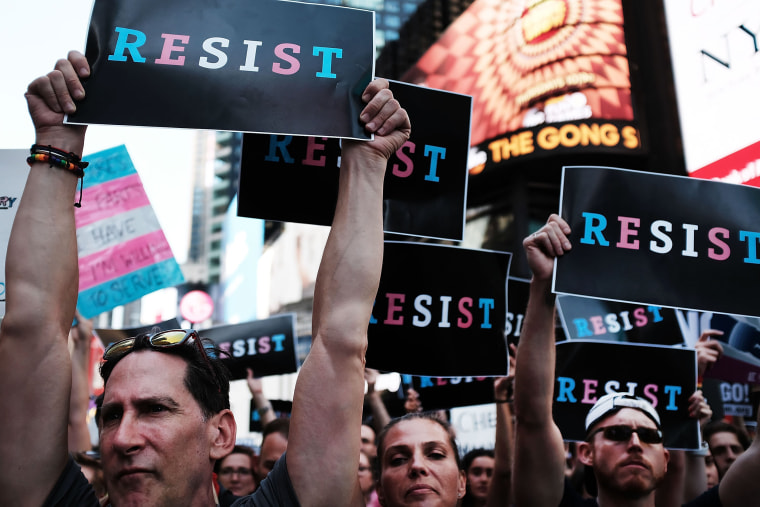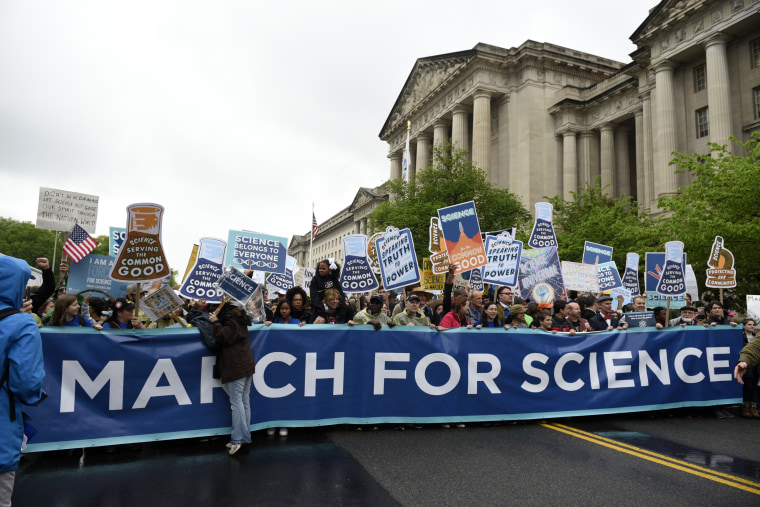WASHINGTON — The pink "pussy hat" is in a museum collection, protesters have left the airports, and George Orwell's "1984" has fallen back off the best-seller list.
But the energy behind the anti-Donald Trump protests that exploded a year ago, which turned everything from T-shirts to yoga into a form of political "resistance," has started to coalesce into a surprisingly sophisticated political force ahead of November's midterm elections.
"Last year we marched and we resisted and we organized, and now we're going to bring that collective power to the polls," said Bob Bland, co-chair of the Women's March. "Moving into 2018, we need to look beyond just 'resistance.'"
This weekend, the anniversary of Trump's inauguration and the massive Women's March that followed, there will be more marches — 389 are planned around the world. But organizers this year are more focused on a new political effort dubbed PowerToThePolls, which aims to register 1 million voters and will kick off Sunday in Las Vegas.
In fact, almost everyone involved in the "Resistance," from scrappy new startups to venerable stalwarts like the American Civil Liberties Union, are turning their focus to the midterms, in which Democrats are trying to seize control of Congress from Republicans.
"Central to our philosophy is fighting the fight at hand. Last year, that was advocacy. This year it's electoral," said Ezra Levin, the co-founder of Indivisible, which started as an organizing guide and has since blossomed into a network of hundreds of local groups across the country. "It's do or die for November."
'Green Shoots' after the fire
It's not an obvious development for a diffusely organized movement that grew up organically around a wide range of issues, from Trump to Islamophobia to sexual harassment to climate science.
The progressive base doesn't tend to care much about midterm elections, let alone far-flung state legislative races, and they were demoralized after Hillary Clinton's defeat in 2016. The last lefty uprising, the Occupy Movement, swore off electoral engagement and eventually petered out.
And while the Women's March in Washington was said to be the largest one-day political mobilization in U.S. history, no one knew whether it could sustain itself or evolve into something besides a protest.

But new groups like Indivisible consciously took a page from the successful tea party movement and found innovative ways to plug the gaps in the Democratic Party's crumbling infrastructure by channeling raw energy into something that could lead to tangible results.
"It's like all these different green shoots coming up after a bad forest fire," said Martin O’Malley, the former Maryland governor who ran for the Democratic presidential nomination in 2016 and has spent the past year campaigning for dozens of low-profile candidates in more than 20 states.
"This isn't the result of some magic memo coming out of DNC headquarters," he said. "While some may not love the Democratic Party's label, we're the only set of brakes in the car and people are tapping it."
And while the visible signs of protest have dissipated, the force behind them remains, activists say.
ActBlue, the online fundraising service used by thousands of progressive groups and candidates, reported no drop-off in the donations they processed over the past year. December was one of their best months of all time.
"Every month was record-breaking for us," said Erin Hill, ActBlue’s executive director. "And if 2017 was off the map already, I can't imagine what 2018 will be."
Some activists have even gone from worrying about whether they would still have a cause to worrying that liberals will take success in the midterms for granted.
"Complacency feels like our worst enemy at the moment," said Ethan Todras-Whitehill, the co-founder of Swing Left, which connects liberal volunteers (often in big cities) and their money with nearby competitive House races. "A wave could happen, but not if we're going to sit around and wait for it to happen — the way we did with Hillary Clinton."
The full impact of new groups like these remains to be seen, but they've already delivered promising results, with Swing Left raising $3.7 million to spend on competitive House races.
Planned Parenthood has been around for decades, but its national field director, Kelley Robinson, had a novel and welcome problem last year of keeping up with demand for work from volunteers.
"The historic resistance that started in 2017 is now shaping into a machine of organizing and activism and policy change that's going to make long-term impact not only for 2018, but for decades to come," Robinson said.
Startup culture
At first, the anti-Trump movement was a cacophonous mix of disruptive startups created by outsiders, legacy groups and even people simply looking to make a quick buck on "Resist" T-shirts and coffee mugs.
There were new political apps for everything, and fierce competition for the time of the newly politically engaged masses.
"People in my life who were not especially political were saying, 'What can I do?' So they would sign up for 19 different email lists and get 19 different things to do," said Nathan Williams, who founded the Town Hall Project, which provides a first-of-its-kind database of congressional public events. "The movement as a whole has gotten better at harmonizing our efforts."
Like their Silicon Valley counterparts, many groups didn't last for various reasons. The creator of one app, Daily Action, which gave users something political to do every day, decided to run for Congress.

But others found a niche by leveraging innovative uses of technology and campaign finance law, often with women taking the lead.
One of those is Sister District, which was founded by a group of women in the San Francisco Bay Area who left successful jobs to work on the project full time.
"None of us had any paid positions of any kind with any political activity," said Gaby Goldstein, who was a bioethics lawyer at a major law firm and working on a Ph.D. at University of California, Berkeley, before becoming Sister District's political director.
Borrowing from the idea of sister cities, the group pairs up teams of liberal volunteers in one place with important state legislative races elsewhere, with the goal of distributing some of the liberal energy and money bottled up in places like New York.
"Many of us live in these deep blue areas and we felt a lot of things after the 2016 election: confused, depressed," said Lala Wu, another co-founder of Sister District. "But one of them was really powerlessness because it felt like there wasn't anything we could do to move the needle from these deep blue areas."
Fourteen of the 15 candidates they supported last year won, with the exception being Democrat Shelly Simonds, a Virginia House of Delegates candidate who lost a dramatic tie-breaker this month when her Republican opponent's name was pulled out of a ceramic bowl, handing the seat to him instead.
From 'Covfefe' toilet paper to a long-term fight
Even as it moves to focus on elections, the "Resistance" was as much a cultural phenomenon as a political one.
The George W. Bush era made heroes of filmmaker Michael Moore and comedian Al Franken, who would later be elected to (and then resign from) the Senate, but politics seems even more pervasive in the Trump era.
The Victoria and Albert Museum in London added a pink "pussy hat," worn at the Women's Marches, to its collection. Pod Save America shot to the top of podcast charts, while "The Handmaid’s Tale," a web television series based on the Margaret Atwood novel about a dystopian patriarchal society, found success for more than just its entertainment value.
A theatrical version of Orwell's "1984" opened on Broadway to positive reviews despite being so graphic that some audience members vomited, fainted, yelled at performers and even got in fist fights.
"It’s staggering, the number of books," the manager of one San Francisco bookstore, referring to anti-Trump releases, told The Associated Press this month. "Politics has a much more prominent place in our store and for our customers than we’ve had for a long time."
And vendors like Etsy exploded with anti-Trump jewelry, wall art, and novelty gifts ("covfefe" toilet paper, anyone?).
But as the movement grew, demand for resistance cultural products died down.
Jay Fanelli, who co-founded a Pittsburgh T-shirt company a few years ago, spent the beginning of 2017 scrambling to keep up with demand for "Rogue NASA" shirts, a design created by an anonymous Twitter account purporting to be run by an anti-Trump staffer at the space agency.
"The resistance found us," Fanelli said. "It totally changed the complexion of the company."
Before Trump, Fanelli's Cotton Bureau would sell around 5,000 to 10,000 shirts a month. After Trump, they sold over 20,000 "Rogue NASA" shirts alone (proceeds went to charity) and thousands more with other designs.
Now, however, things have started to return to normal.
"We made a ton of money because people like making T-shirts making fun of Donald Trump," he said. "The moral quandary of it is not lost on me."
In 2017, even yoga got political as studios offered classes aimed at cultivating personal resilience to keep up the political fight.
"In the beginning, right after the election, there was a sense of panic, everyone was sprinting,” said Julie Eisenberg, who was a professional organizer for progressive causes before opening Lighthouse Yoga Center in Washington, which has taught resistance-themed workshops. "And now people are realizing we have to settle in for a longer-term fight."